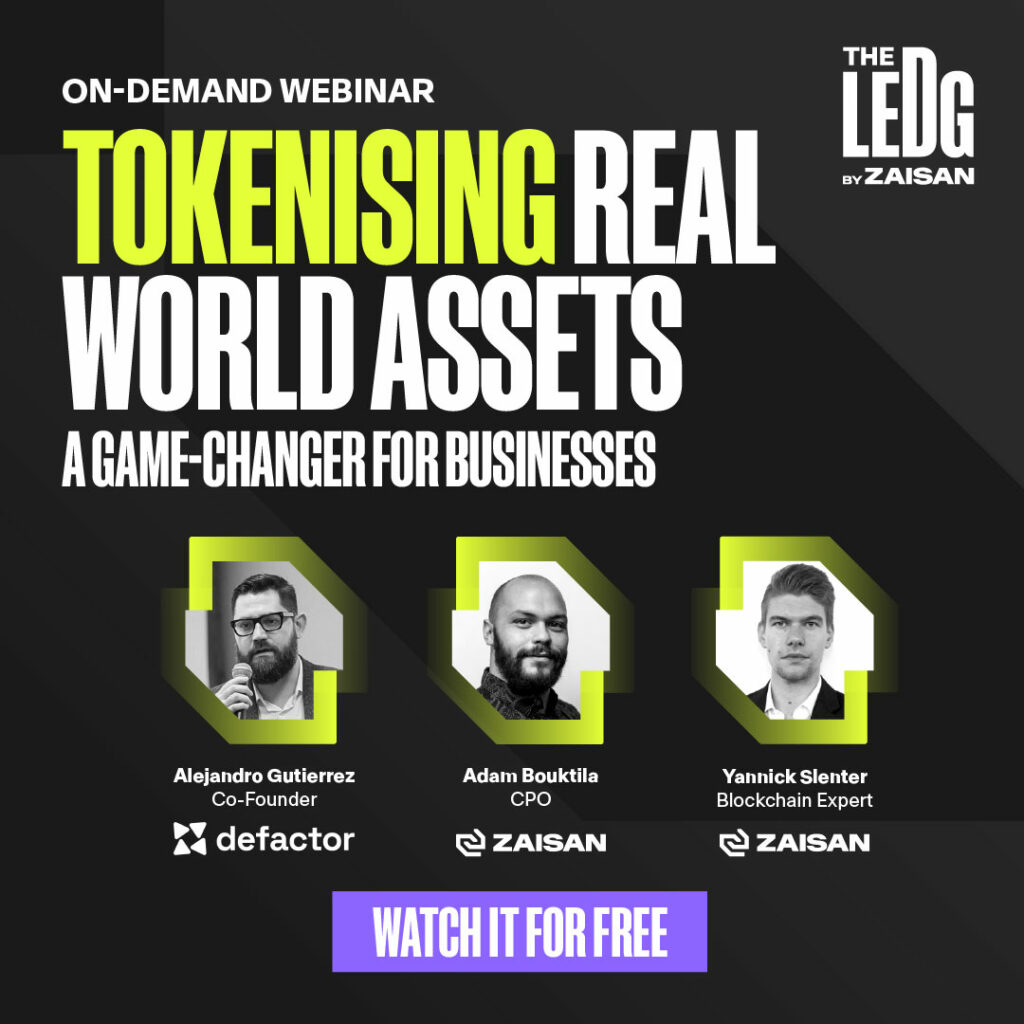Tokenisation and real estate are a match made in heaven. Thus, it is important to understand what goes into tokenising real estate before embarking on your tokenisation journey. In this article, we will discuss how to tokenise real estate, in addition to all the things you need to consider when tokenising real estate, as well as the possible challenges that are out there when it comes to tokenising real estate! Let’s first start with a brief introduction to the process of tokenisation.
Key takeaways
- Tokenising real estate consists of 3 main steps, namely the pre-tokenisation, tokenisation, and post-tokenisation step.
- The pre-tokenisation step consists of formalising the value of the asset, verifying ownership, establishing property management and maintenance processes, establishing various legal requirements, and researching regulatory requirements.
- The tokenisation step consists of selecting the right blockchain, determining the token standard, determining the token structure, setting up the legal framework, selecting the right platform for tokenisation, minting the tokens, and integrating off-chain data.
- The post-tokenisation step consists of selling the tokens, managing the property, monitoring the regulatory environment, and providing investor updates.
- The tokenisation of real estate comes with many legal and regulatory considerations and technical challenges.
- The tokenisation of real estate opens up many new opportunities such as new ways of funding, fractional ownership, unlocking liquidity, new investment avenues, and more.
Brief intro to the tokenisation process
Tokenisation is the process of creating a (blockchain-enabled) digital twin of a real world asset. This process has gained significant attention in recent times, as it allows for the fractional ownership and trading of assets that were previously illiquid, such as real estate, art, or even intellectual property. As explained more in-depth in our “tokenisation of real world assets explained” article, the process of tokenisation can be broken down into three main steps: pre-tokenisation, tokenisation, and post-tokenisation.
The pre-tokenisation step involves formalising the value of the asset, verifying ownership, and ensuring the proper processes are in place for maintenance, management, and legal compliance. The tokenisation step involves creating a digital representation of the asset in the form of tokens and ensuring that all relevant information about the asset is accurately represented on the blockchain. Oracles are a common solution to enable the connection between traditional databases and the blockchain. Finally, the post-tokenisation step involves the perpetual management of both the physical asset and the tokens. This includes their distribution and sale through specialised marketplaces or offerings.
Tokenisation has numerous benefits for the real estate industry. Firstly, it allows for fractional ownership, which enables investors to purchase and trade smaller portions of a property. This creates opportunities for smaller investors to enter the market and diversify their portfolios with real estate assets. Tokenisation also provides liquidity to real estate assets, allowing investors to buy and sell their tokens on secondary markets. This means that investors can realise their returns without waiting for the property to be sold. Finally, tokenisation can provide increased transparency and traceability of ownership. Tracking each token on the blockchain reduces the potential for fraud and disputes.
However, it also comes with its own set of challenges, including regulatory compliance, data privacy, and the potential for fraudulent activities. Therefore, it is important to carefully consider the risks and benefits associated with tokenising a particular asset before embarking on the process. We will discuss the potential challenges more in-depth later in this article. Let’s first take a more in-depth look at what you need to consider when tokenising real estate.

What to consider when tokenising real estate
Tokenising real estate is a complex process that requires careful consideration of various aspects. So before delving into the actual tokenisation process, let’s take a look at the following essential aspects to consider when tokenising real estate:
- Regulatory compliance
- Legal structure
- Fractionalisation
- Alternative financing options
- Liquidity & trading
Regulatory compliance
Let’s start with regulatory compliance. One of the key regulatory requirements to consider when tokenising real estate is compliance with securities laws. Most jurisdictions consider the tokenisation of real estate as a security offering and subject it to the same regulatory requirements as traditional securities offerings. This also includes complying with securities laws related to registration, disclosure, and anti-fraud measures.
Additionally, anti-money laundering (AML) laws and regulations must be carefully considered and complied with when tokenising real estate. This is particularly important when dealing with cross-border transactions, as different countries have different AML regulations and requirements. Ensuring a clear definition of the ownership of the real estate is crucial. Also, there should be proper legal agreements in place to govern the rights and obligations of all parties involved.
Moreover, it is important to note that the regulatory framework for tokenisation of real estate is still developing. The legal requirements can vary widely depending on the country or region in question. Therefore, one should seek legal advice and guidance to ensure that they meet all legal and regulatory requirements. Additionally, as the regulatory framework develops it is important to monitor any changes to prevent non-compliance with new regulations.
Lastly, while it is a key aspect to consider when tokenising real estate, regulatory complexity can be reduced by offering the tokenised real estate in smaller and more specific regions, as well as by tokenising real estate in jurisdictions which have more clear regulations surrounding tokenising real estate.
Legal structure
Another important aspect to consider when tokenising real estate is the legal structure. While the legal structure for tokenising retail and residential buildings is relatively similar, it is necessary to take into account the ownership structure and protection of underlying assets. This entails selecting the appropriate legal entity for holding the real estate. Namely, a limited liability company (LLC) or a real estate investment trust (REIT), defining ownership rights and obligations, as well as setting up appropriate governance structures and auditing measures.
In addition to selecting the right legal entity for holding the real estate, it is also crucial to establish ownership agreements that clearly define the rights and obligations of all parties involved in the tokenisation process. This includes establishing clear rules for how the real estate will be managed, maintained, and potentially sold in the future. It is important to consult with legal and financial experts to ensure that the ownership agreements are comprehensive and cover all necessary aspects of the tokenisation process.
Fractionalisation
As mentioned in our previous article about tokenising real world assets, fractionalisation of real estate through tokenisation allows for more flexible ownership structures. This makes it more appealing to a wider range of investors. It also enables investors to purchase smaller portions of an asset, making real estate investments accessible to those who may not have the capital to purchase an entire property.
However, it is important to also consider the potential downside of fractionalisation, as it can lead to the fragmentation of ownership. As more investors become involved in the ownership of the asset, it becomes increasingly difficult to reach consensus on decisions related to the asset. This can result in conflicts between token holders, which can ultimately impact the value of the asset. Therefore, it is crucial to have a clear governance structure in place to manage decision-making and conflict resolution among token holders.
Lastly, it is essential to ensure that the real estate asset being tokenised is properly evaluated and accurately reflected in the tokenised value. This includes conducting a thorough assessment of the property’s physical condition, location, and market value. Accurately evaluating the property can help prevent overvaluation or undervaluation of the asset. Consequently, which can have negative implications for both the issuer and investors.
Alternative financing options
As more investors are able to invest in real estate projects through tokenisation, it can provide alternative financing options for projects that may not have been possible before. Tokenisation can open up access to a broader range of investors. Including those who may not have been able to invest in traditional real estate investments. This can provide more flexibility for project financing. Furthermore, it may lead to increased competition for funding, potentially lowering the cost of capital for real estate projects.
However, it is important to carefully consider the potential impact on the financial structure of the real estate asset. Tokenisation can lead to changes in ownership rights, cash flow distribution, and financing arrangements. It is important to evaluate the potential risks and benefits of tokenisation to ensure that it aligns with the project’s financing goals and objectives. Additionally, it is also important to ensure that token holders have a clear understanding of the financial structure of the asset. This includes any potential risks, limitations, and liabilities associated with token ownership. Proper due diligence and risk assessment should be conducted to ensure that the tokenisation of real estate projects is done in a responsible and effective manner.
Liquidity & trading
The final aspect to consider is the liquidity and trading aspect of tokenising real estate. As also discussed in some of the other aspects of tokenising real estate, tokenisation has the potential to increase the liquidity of real estate assets. It allows for the creation of digital assets that can be traded quickly and efficiently. This can be beneficial for investors who are looking for an easy way to exit their investments. However, it is important to consider the potential impact on the trading of the real estate asset. For instance, tokenisation can result in changes to the underlying value of the asset, market demand, and price volatility.
One of the advantages of tokenisation is that it allows for the creation of smoother secondary markets, which can increase liquidity and trading volume. This can also benefit investors who are looking to sell their tokens and exit their investments quickly. However, it is important to ensure that there is adequate market demand for the tokenised asset. The market cannot be too illiquid. Investors should also consider the potential risks associated with market volatility. The value of the tokenised asset can fluctuate rapidly in response to changes in market conditions. Therefore, it is crucial to have a well-defined exit strategy in place that takes into account these potential risks and benefits of tokenisation.
All in all, tokenising real estate requires careful consideration of various aspects such as regulatory compliance, the legal structure, fractionalisation, alternative financing options, and liquidity and trading. By addressing these key considerations, tokenisation can offer significant benefits for both investors and issuers. However, before embarking on a tokenisation project it is crucial to do a thorough assessment of the potential risks and benefits involved.
How to tokenise real estate
Now you are aware of the things you need to consider when tokenising real estate. Let’s take a deeper look at the exact steps involved in every stage of tokenising real estate.
Pre-tokenisation steps for real estate
- Formalising the value of the real estate asset
- Verifying ownership of the real estate asset
- Ensuring the right processes are in place for maintenance and management of the property
- Establishing legal requirements for liquidations, dispute resolutions, and enforcement
- Review of the regulatory requirements
During the pre-tokenisation step there are various things to do in the real, non-digital, world before the asset can get tokenised. One of these steps is formalising the value of the real estate. This involves assessing the value of the property based on various factors such as location, size, condition, and potential for income or appreciation. Valuation is typically done by a licensed appraiser who provides an appraisal report that outlines the value of the property. Determining the value of the tokens that will be created and sold on the blockchain is crucial at this step.
The verification of ownership is also critical in the pre-tokenisation process for real estate assets. This involves conducting title searches, surveys, and reviewing legal documentation to ensure that the person or entity claiming ownership of the property has a legitimate claim to it. This step helps to avoid disputes over ownership of the asset in the future.
In addition to verifying ownership, it is important to have processes in place for the maintenance and management of the physical property. This includes tasks such as property management, repairs, and maintenance of the property. Establishing a maintenance plan and budget is crucial to ensuring that the physical asset remains in good condition and retains its value over time. Furthermore, in this stage, it is also important to establish how the property can be used.
Another part of this step is establishing the legal requirements for liquidations, dispute resolutions, and rule enforcement. Establishing these is a prerequisite for tokenisation to occur. This includes creating contracts, deeds, and insurance policies that cover the ownership and use of the property. Having these legal requirements in place helps to mitigate risk and provides a framework for addressing any disputes or issues that may arise during or after the tokenisation process.
Lastly, it is important to do a careful analysis of the regulatory requirements before you start the tokenisation process. This analysis should look at the regulatory requirements for tokenising real estate, as well as the regulatory requirements for offering tokenised assets in the specific jurisdiction(s) in which you plan on tokenising the property as well as the specific jurisdiction(s) in which you plan on distributing the tokenised asset.
Tokenisation steps for real estate
- Selecting the right blockchain for the tokenisation
- Identify the type of token standard that will be used
- Determine the token structure
- Prepare the legal framework for the issuance of the tokens
- Choose a platform to use for the tokenisation
- Minting the tokens
- Ensure all relevant information about the asset is represented on-chain
After all pre-tokenisation steps are completed you can move on to the actual tokenisation. The tokenisation process for real estate starts with selecting a blockchain on which you will tokenise your asset. This part is critical, as it determines the type of token standards, marketplaces, and technical abilities at your disposal. It is important to research these areas and make an informed decision about the blockchain you plan to use for the tokenisation process.
Once you have found a blockchain that matches your needs, you can select the specific token standard that you will use for your token. The token standard determines whether a token is fungible or non-fungible. Also, what kind of other properties it has, or can have. Generally speaking, a common token standard such as the commonly used ERC-20 token standard on Ethereum can be used for this. But with various purpose-built real estate token standards on the rise on various protocols, it’s worth keeping an eye out for more specific token standards that better suit the needs of tokenised real estate.
Determining the token structure follows the selection of the token standard. This refers to the number of tokens to be issued and their value. This is based on the value of the underlying real estate asset. Then, the legal framework for the issuance of the tokens is prepared, including documentation of ownership and the legal rights associated with the tokens.
The next crucial decision is to choose a suitable platform for the tokenisation process. In order to ensure that the chosen platform aligns with the requirements of the real estate asset being tokenised, one must carefully consider factors such as scalability, security, and cost. And while offering the tokens on a marketplace is typically part of the post-tokenisation process, it is worth noting that certain marketplaces offer an integrated tokenisation solution. These platforms provide the ability to carry out the tokenisation process and mint the tokens directly on their marketplace. This is a more streamlined approach that can make everything more efficient by eliminating the need for separate token minting procedures.
However, if the chosen marketplace or platform does not have built-in token minting capabilities, alternative options are available. In this case, you can either mint the tokens independently or collaborate with a technology partner. Regardless of the decisions in this part of the tokenisation step, it is important to ensure your tokens are ready for sale and/or distribution before the post-tokenisation step.
Lastly, in order to ensure that all relevant information about the asset is accurately represented on the blockchain, including the property’s location, size, ownership, and legal rights associated with the tokens, it is essential to utilise oracles to integrate relevant off-chain data with the blockchain. These oracles collect data from traditional databases and broadcast it to the blockchain. Information that would have to get updated regularly would be any information regarding expenses and (rental) income, maintenance and repairs, etc. Another option for managing this information would be pointing to a regular database from the blockchain. Although, generally speaking, the use of oracles to put this off-chain information on-chain is preferred. It is more transparent and prevents the loss of data in case anything happens with the regular database.
Post-tokenisation steps for real estate
- Distribute/sell the tokenised assets through specialised marketplaces or offerings
- Perpetual management of the property and the tokens based on the rules previously set
- Continuous monitoring of the regulatory environment
- Providing ongoing investor updates
Once someone creates tokenised real estate assets, the next step is to distribute or sell them through specialised marketplaces or offerings. These marketplaces typically enable buyers to access assets either directly from the seller or through a secondary market. Additionally, these marketplaces can provide investors with an opportunity to invest in a diversified portfolio of real estate assets, which can be particularly attractive for those who do not have the financial resources to purchase an entire property, or want easier access to foreign real estate.
Once the tokenised real estate asset has been sold/distributed (or is being sold/distributed), the perpetual management of both the physical asset and the tokens is key. This includes managing things such as repairs, insurance, leasing, etc. of the physical property, as well as the ongoing management of information about the token on-chain. The perpetual management of the physical asset may involve hiring a property manager to handle day-to-day operations such as maintenance and leasing. Meanwhile, the management of the tokens may require the ongoing monitoring of the blockchain platform used for the tokenisation to ensure that the tokens continue to function properly and that all relevant information is accurately represented.
In this part of the tokenisation process it is also important to continuously monitor the regulatory environment to ensure compliance with applicable laws and regulations. Changes in laws and regulations could impact the ability to distribute or sell the tokenised assets, as well as the ongoing management of the asset.
Finally, providing ongoing investor updates is crucial for maintaining investor confidence and trust. This could include regular financial reporting, updates on property management activities, and other relevant information. Communication with investors can also help to build relationships and foster a sense of community among token holders.

The challenges of tokenising real estate
While there are clear benefits to tokenising real estate, there is also a multitude of challenges that need to be considered in order to prevent issues down the line. These challenges can be summarised as follows:
- Legal complexity
- Technical challenges
- Adoption and education
Legal complexity
The legal complexity of tokenising real estate is one of the biggest challenges in this field. There are many legal and regulatory hurdles that need to be overcome before a property can be tokenised. In particular, the ownership and transfer of real estate is subject to a variety of laws and regulations that can vary significantly from jurisdiction to jurisdiction. Creating a standardised tokenisation process that can be applied globally can be difficult due to this.
Furthermore, the legal framework for tokenisation is still in its infancy. This means that there is a lot of uncertainty surrounding the legality of the process in many countries. This can create significant barriers to adoption. Investors and issuers alike may be hesitant to get involved with a technology that is not yet fully understood from a legal perspective.
Another legal challenge associated with tokenising real estate is the issue of cross-border transactions. Securities laws and regulations differ significantly across different jurisdictions, which can create difficulties when selling security tokens across borders. In particular, issuers and investors may need to comply with complex rules around cross-border offerings and sales, which can be a significant barrier to entry for smaller investors.
Additionally, different countries may have different rules around the transfer of real estate, which can further complicate the legal picture. As a result, it is important to carefully consider which jurisdictions to target when offering tokenised real estate.
Technical challenges
Tokenising real estate also brings technical challenges. It requires a secure and scalable blockchain infrastructure capable of handling large transactions of high value assets. The blockchain platform must ensure that the tokens can be easily traded, while also providing transparency and security for investors. While most modern blockchains are perfectly capable of these tasks, it is also important that the marketplaces on top of these blockchains have the required capabilities, such as the ability to oversee the perpetual management of the physical property and the tokens, managing the distribution of profits, the opportunity to resolve disputes, and more. While more and more marketplaces and platforms with these capabilities are being developed, it is important to tackle this challenge by monitoring what is out there and bringing technically proficient members or partners on board to assist you with the process in the meantime.
Another technical challenge is the integration of off-chain information with the blockchain. As discussed earlier, tokenising real estate requires the sharing of various off-chain information, including property valuations, surveys, and legal documentation. Either through oracles or other mechanisms, the information must be accurately represented on the blockchain. Ensuring the accuracy of this information is critical to the functioning of the tokens and the transparency of the investment. Moreover, the integration of off-chain information with the blockchain raises additional technical challenges, such as data privacy and security, which also vary per jurisdiction.
Adoption and education challenges
Another challenge of tokenising real estate is the need for education and adoption. Tokenisation is a relatively new concept with many investors being unfamiliar with the benefits and risks associated with this type of investment. In this stage, education is crucial to ensure that investors understand the technology, the risks and opportunities involved, as well as the legal and regulatory framework. Moreover, real estate professionals, such as property managers and developers, will also need to be educated about tokenisation and how it can benefit their businesses.
Adoption of tokenisation may also face difficulties due to the conservative nature of the real estate industry. Real estate has traditionally been a relatively stable and conservative investment. Many investors and professionals may be hesitant to adopt new technologies or investment structures. Convincing these individuals and professionals of the benefits of tokenisation, as well as assisting them with actually tokenising their real estate, will require significant effort and time.
Conclusion
In conclusion, tokenising real estate opens up many new opportunities such as new ways of funding, fractional ownership, unlocking liquidity, new investment avenues, and more. However, it is crucial to carefully consider the complex legal landscape and to address the various considerations in order to ensure a successful tokenisation process.
Working with a knowledgeable tokenisation partner can prove invaluable in navigating these challenges, providing expert guidance on both the technical and legal aspects of the tokenisation process. All in all, tokenising real estate can be a complex, yet very rewarding process if done correctly.
A special thanks to Alexander Rapatz of Black Manta for his contributions to the article.




